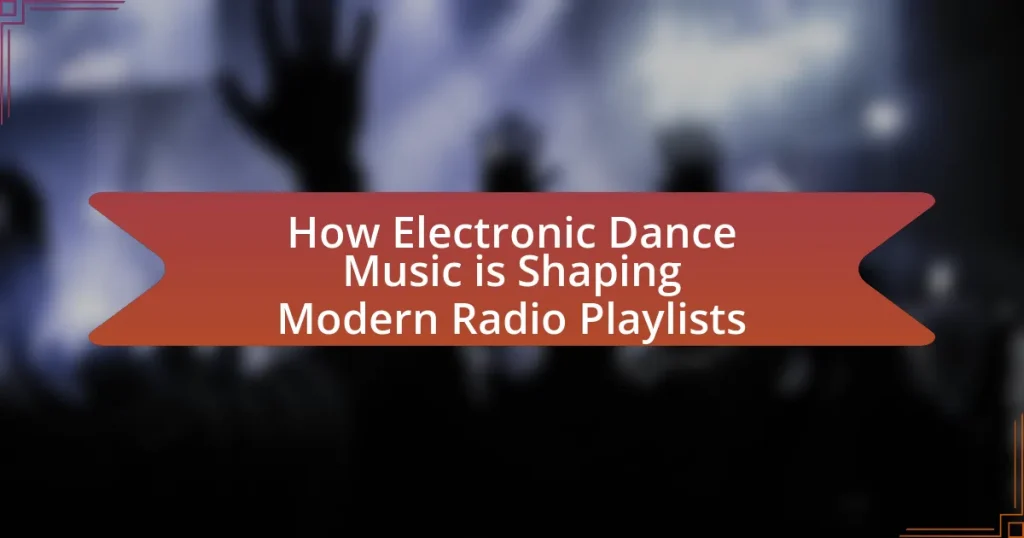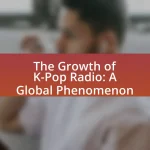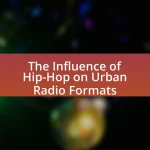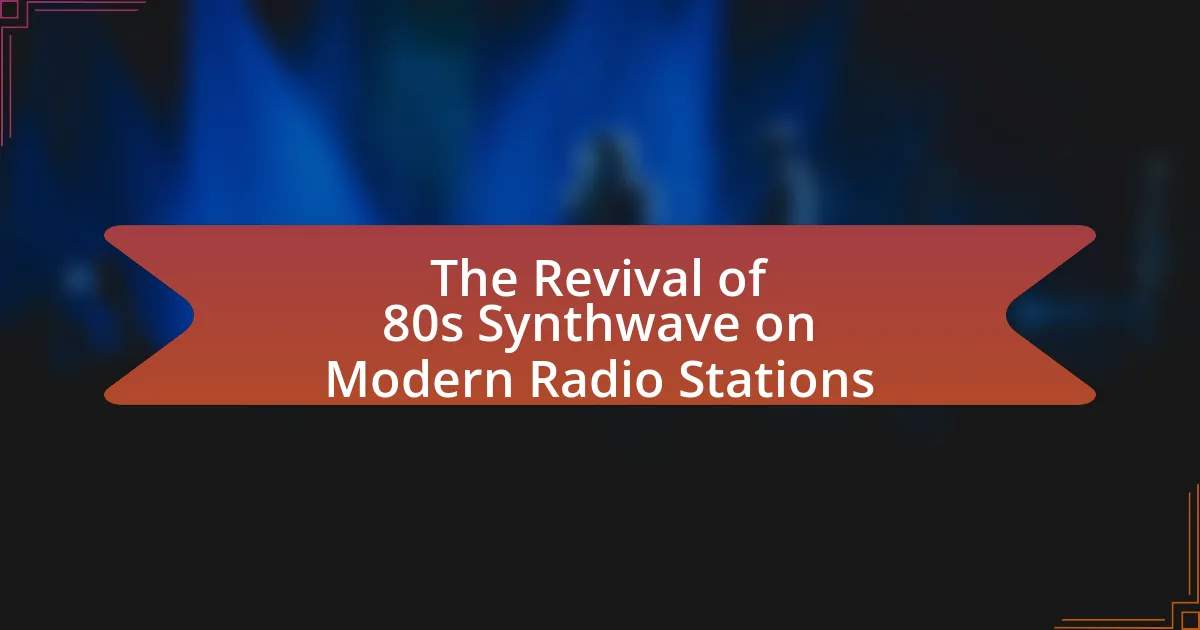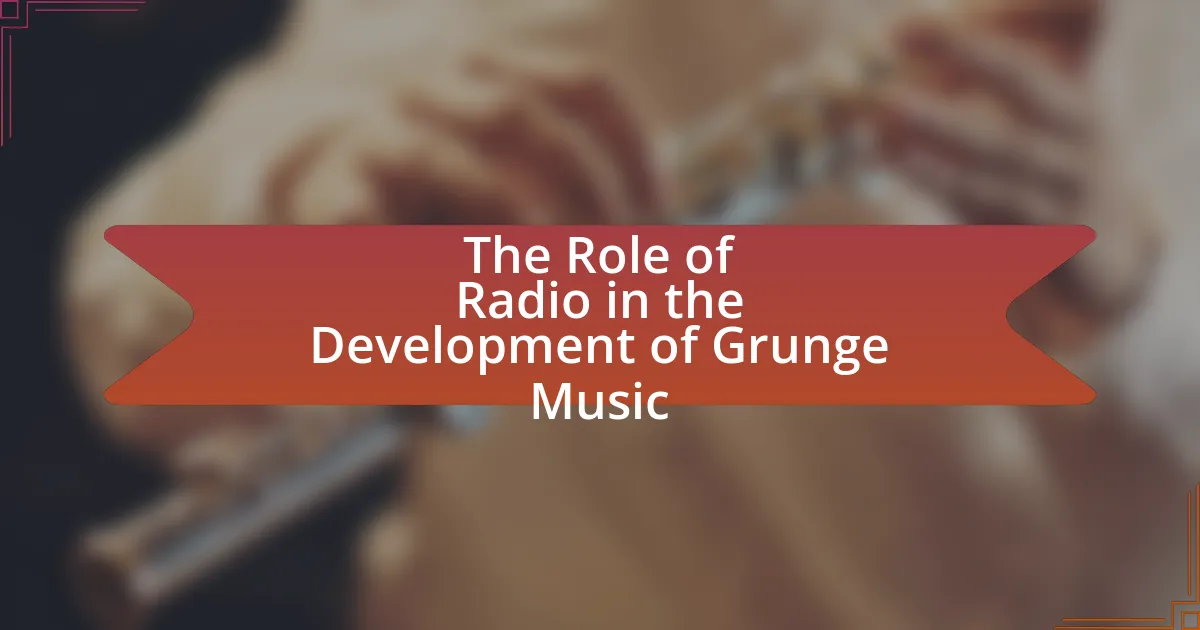Electronic Dance Music (EDM) is increasingly shaping modern radio playlists by integrating electronic sounds and beats into mainstream music. The genre’s rise has led to notable collaborations between EDM artists and popular musicians, resulting in chart-topping hits that blend various styles. Key characteristics of EDM, such as its energetic tempo and use of synthesizers, contribute to its appeal, particularly among younger demographics. The article explores how radio stations are adapting their playlists to include more EDM tracks, the impact of social media and streaming platforms on its popularity, and the challenges faced in integrating this genre into traditional radio formats. Additionally, it discusses trends in collaborations, remixes, and the influence of live events on radio airplay, highlighting the future prospects for EDM in radio programming.
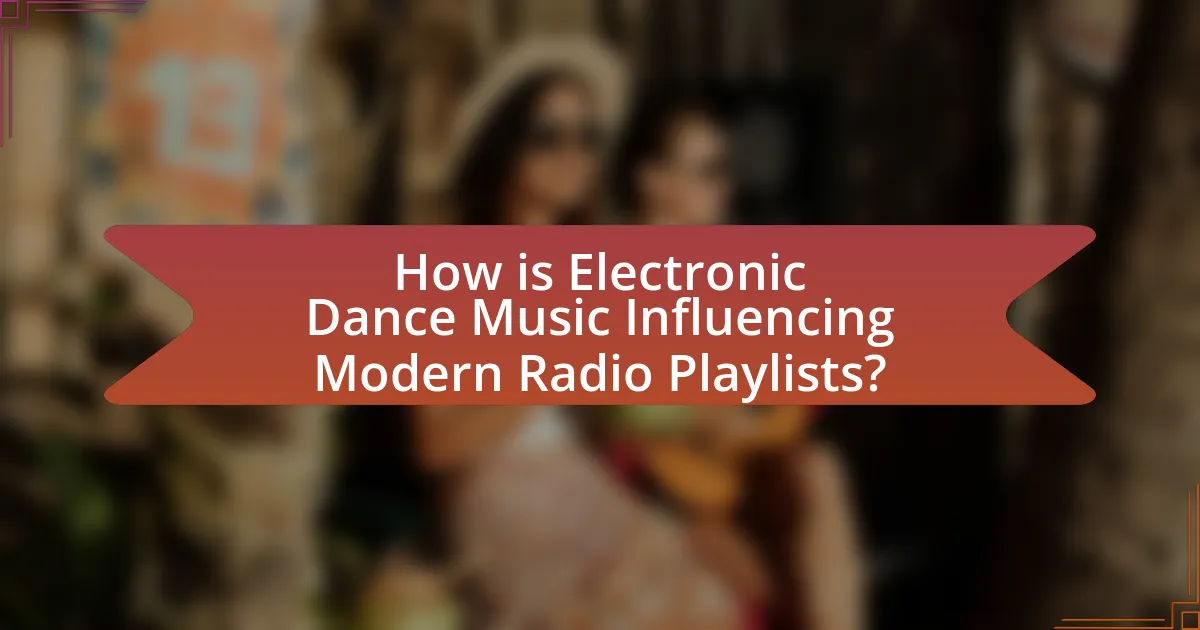
How is Electronic Dance Music Influencing Modern Radio Playlists?
Electronic Dance Music (EDM) is significantly influencing modern radio playlists by increasing the prevalence of electronic sounds and beats in mainstream music. This genre’s rise has led to collaborations between EDM artists and popular musicians, resulting in chart-topping hits that blend electronic elements with pop, hip-hop, and other genres. For instance, songs like “Despacito” (remix featuring Justin Bieber) and “Stay” by Zedd and Alessia Cara showcase how EDM influences are reshaping radio content. Additionally, data from Nielsen Music indicates that EDM tracks have seen a substantial increase in airplay, reflecting a shift in listener preferences towards more danceable and electronic-infused music. This trend demonstrates that radio stations are adapting their playlists to align with the growing popularity of EDM, thereby reshaping the overall soundscape of contemporary radio.
What are the key characteristics of Electronic Dance Music?
Electronic Dance Music (EDM) is characterized by its use of electronic instruments, repetitive beats, and synthesized sounds. The genre typically features a tempo ranging from 120 to 150 beats per minute, which facilitates dancing and creates an energetic atmosphere. Additionally, EDM often incorporates build-ups and drops, creating dynamic shifts in intensity that engage listeners. The use of digital audio workstations (DAWs) for production allows for intricate layering of sounds and effects, contributing to its unique sonic texture. Furthermore, EDM encompasses various subgenres, such as house, techno, and dubstep, each with distinct stylistic elements, yet all share the foundational characteristics of electronic instrumentation and rhythmic focus.
How do tempo and rhythm define Electronic Dance Music?
Tempo and rhythm are fundamental elements that define Electronic Dance Music (EDM) by establishing its energetic and danceable nature. Typically, EDM features a tempo ranging from 120 to 150 beats per minute, which creates an upbeat and engaging atmosphere conducive to dancing. The rhythm in EDM is characterized by repetitive beats and syncopated patterns, which enhance the groove and encourage movement on the dance floor. This rhythmic structure is often reinforced by the use of kick drums and hi-hats, creating a driving force that propels the music forward. The combination of these tempo and rhythmic elements not only shapes the sound of EDM but also influences its integration into modern radio playlists, as stations seek tracks that resonate with listeners and inspire them to dance.
What role do synthesizers and technology play in Electronic Dance Music?
Synthesizers and technology are fundamental to Electronic Dance Music (EDM), as they enable the creation of unique sounds and complex compositions. Synthesizers allow producers to generate a wide range of tones and textures, which are essential for crafting the distinctive beats and melodies characteristic of EDM. Additionally, technology such as digital audio workstations (DAWs) and software plugins enhances production capabilities, allowing for intricate layering, effects processing, and real-time manipulation of sound. The integration of these tools has led to the evolution of EDM, making it a dominant genre in modern radio playlists, as evidenced by the genre’s significant presence on platforms like Spotify and Billboard charts, where EDM tracks frequently achieve high rankings.
Why has Electronic Dance Music gained popularity in radio play?
Electronic Dance Music (EDM) has gained popularity in radio play due to its infectious beats and broad appeal across diverse demographics. The genre’s rise can be attributed to its integration into mainstream pop music, with artists like Calvin Harris and David Guetta collaborating with top vocalists, thereby increasing its visibility. Additionally, the growth of music festivals and events dedicated to EDM has created a cultural phenomenon that radio stations capitalize on to attract younger audiences. According to a 2020 report by the International Music Summit, the global electronic music market was valued at $7.3 billion, highlighting its significant impact on the music industry and radio playlists.
What demographic trends are driving the rise of Electronic Dance Music on the radio?
The rise of Electronic Dance Music (EDM) on the radio is primarily driven by the increasing popularity among younger demographics, particularly Millennials and Generation Z. These age groups, who are now the largest consumers of music, have shown a strong preference for EDM genres, leading to a significant increase in radio airplay. According to a 2021 report by the International Music Summit, the global electronic music market was valued at $7.3 billion, with a substantial portion attributed to the youth demographic’s engagement with streaming platforms and radio. This trend is further supported by the integration of EDM into mainstream pop music, as artists collaborate with EDM producers, thereby broadening the genre’s appeal and increasing its presence on radio playlists.
How do social media and streaming platforms contribute to this popularity?
Social media and streaming platforms significantly enhance the popularity of electronic dance music (EDM) by providing artists with direct access to audiences and facilitating viral trends. These platforms enable artists to share their music widely, engage with fans in real-time, and promote events, leading to increased visibility and listener engagement. For instance, platforms like Spotify and SoundCloud allow users to discover new tracks through curated playlists and algorithm-driven recommendations, which have been shown to boost streaming numbers and chart performance. Additionally, social media platforms like Instagram and TikTok have become essential for marketing, where short clips of EDM tracks can go viral, further driving interest and attendance at live events. This interconnected ecosystem of social media and streaming services creates a feedback loop that amplifies the reach and impact of EDM, contributing to its growing presence in modern radio playlists.
What impact does Electronic Dance Music have on radio programming?
Electronic Dance Music (EDM) significantly influences radio programming by driving the inclusion of more electronic tracks in playlists. This genre’s popularity has led radio stations to adapt their formats to attract younger audiences, resulting in a shift towards more upbeat and dance-oriented music. For instance, according to a 2021 report by Nielsen Music, EDM tracks accounted for over 20% of the top 100 songs played on radio, reflecting its growing presence. Additionally, major radio networks have launched dedicated EDM shows and channels, further integrating the genre into mainstream programming.
How are radio stations adapting their playlists to include more Electronic Dance Music?
Radio stations are adapting their playlists to include more Electronic Dance Music (EDM) by integrating popular EDM tracks into their rotation and collaborating with EDM artists for exclusive content. This shift is driven by the genre’s growing mainstream popularity, evidenced by the fact that EDM festivals attract millions of attendees annually, such as the Electric Daisy Carnival, which drew over 400,000 participants in 2019. Additionally, radio stations are leveraging data analytics to identify listener preferences, leading to a strategic increase in EDM tracks that resonate with their audience, thereby enhancing listener engagement and ratings.
What challenges do radio stations face when integrating Electronic Dance Music?
Radio stations face several challenges when integrating Electronic Dance Music (EDM), primarily due to audience demographics, licensing issues, and content diversity. The audience for EDM is often younger and may not align with the traditional listener base of many radio stations, making it difficult to attract and retain listeners. Additionally, licensing for EDM tracks can be complex, as many songs involve multiple producers and remixers, complicating the rights acquisition process. Furthermore, radio stations must balance their playlists to include a variety of genres, which can dilute the focus on EDM and limit its representation in programming. These factors collectively hinder the effective integration of EDM into radio playlists.
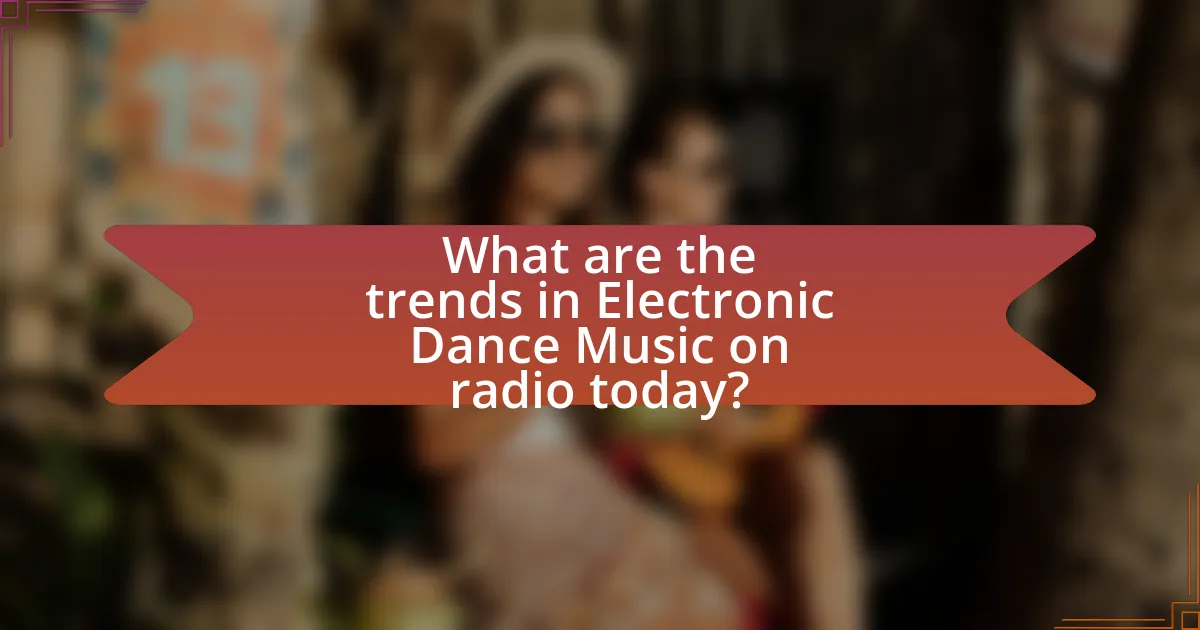
What are the trends in Electronic Dance Music on radio today?
The current trends in Electronic Dance Music (EDM) on radio today include a significant rise in collaborations between mainstream pop artists and EDM producers, leading to increased airplay of hybrid tracks. This trend is evidenced by the success of songs like “Stay” by The Kid LAROI and Justin Bieber, which blends pop and EDM elements, showcasing how radio playlists are increasingly favoring tracks that appeal to a broader audience. Additionally, the integration of EDM into various genres, such as hip-hop and pop, reflects a shift in radio programming that prioritizes cross-genre appeal, as seen in the popularity of tracks featuring EDM drops within hip-hop songs. Furthermore, the use of streaming data to curate playlists has led to a more data-driven approach in selecting EDM tracks for airplay, ensuring that radio stations align with listener preferences and current trends.
How are collaborations between artists shaping radio playlists?
Collaborations between artists are significantly shaping radio playlists by blending diverse musical styles and expanding audience reach. These partnerships often result in tracks that combine elements from different genres, appealing to a broader demographic and increasing listener engagement. For instance, collaborations between electronic dance music (EDM) artists and mainstream pop singers have led to chart-topping hits, such as “Where Are Ü Now” by Skrillex and Diplo featuring Justin Bieber, which showcases how cross-genre collaborations can dominate radio airplay. This trend is supported by data indicating that songs featuring multiple artists tend to receive more radio spins, as they attract fans from each artist’s fanbase, thereby enhancing overall playlist performance.
What are some notable collaborations that have influenced radio play?
Notable collaborations that have influenced radio play include “Where Are Ü Now” by Skrillex and Diplo featuring Justin Bieber, which topped charts and received extensive airplay, showcasing the blending of electronic dance music with pop. Another significant collaboration is “Titanium” by David Guetta featuring Sia, which became a global hit and is frequently played on radio stations, highlighting the impact of EDM on mainstream music. Additionally, “Stay” by Zedd and Alessia Cara gained massive radio traction, illustrating how EDM collaborations can dominate playlists and shape listener preferences. These collaborations exemplify the successful integration of electronic music elements into popular radio formats, driving significant listener engagement and chart success.
How do remixes of popular songs affect their airplay on radio?
Remixes of popular songs significantly increase their airplay on radio. This phenomenon occurs because remixes often rejuvenate interest in a track, making it more appealing to diverse audiences and fitting various radio formats. For instance, a study by Nielsen Music found that remixed versions of songs can lead to a 30% increase in radio spins compared to the original versions. Additionally, remixes can introduce new elements, such as different beats or collaborations with other artists, which can attract listeners who may not have engaged with the original track. This strategy is particularly effective in the electronic dance music genre, where remixes are a common practice, further solidifying their impact on modern radio playlists.
What role do festivals and live events play in promoting Electronic Dance Music on radio?
Festivals and live events play a crucial role in promoting Electronic Dance Music (EDM) on radio by creating a direct connection between artists and audiences, which enhances listener engagement. These events serve as platforms for artists to showcase their music, leading to increased airplay on radio stations that aim to capture the excitement generated by these live performances. For instance, major festivals like Tomorrowland and Ultra Music Festival often feature exclusive sets and collaborations, which subsequently influence radio playlists as stations seek to capitalize on trending tracks and popular artists. Additionally, radio stations frequently broadcast live sets or highlight festival lineups, further integrating the festival experience into their programming and expanding the reach of EDM. This symbiotic relationship between festivals and radio not only boosts the visibility of EDM but also drives listener interest and participation in the genre.
How do major festivals influence radio playlist selections?
Major festivals significantly influence radio playlist selections by showcasing trending artists and popular tracks that gain increased visibility during these events. Radio stations often curate their playlists to align with the music featured at major festivals, such as Tomorrowland or Coachella, to attract listeners who are interested in the festival experience. For instance, data from the International Music Summit indicates that tracks performed at these festivals often see a spike in streaming and radio play, as audiences seek to connect with the music they experienced live. This trend demonstrates how the festival environment acts as a catalyst for radio stations to adapt their playlists, ensuring they remain relevant and appealing to their audience.
What is the relationship between live performances and radio airplay?
Live performances significantly influence radio airplay by enhancing an artist’s visibility and popularity. When artists perform live, they often attract larger audiences, which can lead to increased streaming and sales of their music. This heightened interest can prompt radio stations to add their tracks to playlists, as stations aim to feature popular and trending music that resonates with listeners. For instance, a study by Nielsen Music found that songs performed at major festivals often see a spike in radio airplay shortly after the event, demonstrating a direct correlation between live performance exposure and subsequent radio play.

How can radio stations effectively incorporate Electronic Dance Music into their playlists?
Radio stations can effectively incorporate Electronic Dance Music (EDM) into their playlists by strategically blending popular EDM tracks with mainstream hits to attract a wider audience. This approach leverages the growing popularity of EDM, which accounted for 25% of global music consumption in 2020, according to the International Federation of the Phonographic Industry. By featuring well-known EDM artists alongside chart-topping pop songs, radio stations can create a dynamic listening experience that appeals to both EDM enthusiasts and casual listeners. Additionally, incorporating remixes of popular songs into the EDM genre can further enhance listener engagement and keep the playlist fresh and relevant.
What strategies can radio stations use to engage listeners with Electronic Dance Music?
Radio stations can engage listeners with Electronic Dance Music (EDM) by curating specialized playlists, hosting live DJ sets, and utilizing social media for interaction. Curated playlists featuring popular and emerging EDM tracks can attract dedicated listeners, as evidenced by the success of stations like SiriusXM’s Electric Area, which focuses exclusively on EDM. Hosting live DJ sets or guest mixes creates an immersive experience, allowing listeners to feel connected to the music and the artists, similar to events like Tomorrowland, which have massive followings. Additionally, leveraging social media platforms for listener polls, contests, and real-time feedback fosters community engagement, as seen with platforms like Instagram and TikTok, where EDM artists and fans actively interact. These strategies collectively enhance listener engagement and loyalty to radio stations that prioritize EDM.
How can radio stations balance Electronic Dance Music with other genres?
Radio stations can balance Electronic Dance Music (EDM) with other genres by curating playlists that incorporate a diverse range of musical styles while strategically scheduling EDM tracks during peak listening times. This approach allows stations to cater to a broader audience, ensuring that EDM is featured alongside pop, rock, hip-hop, and other genres, thus maintaining listener engagement. Research indicates that stations that blend genres effectively can increase listener retention; for example, a study by Nielsen Music found that 70% of listeners enjoy a mix of genres, which supports the idea that variety can enhance the overall listening experience.
What are some best practices for curating Electronic Dance Music playlists?
To curate Electronic Dance Music playlists effectively, focus on a cohesive theme that resonates with the intended audience. This involves selecting tracks that share similar energy levels, moods, or sub-genres, ensuring a seamless listening experience. Additionally, incorporating a mix of well-known hits and emerging artists can enhance the playlist’s appeal, as it balances familiarity with discovery.
Data from Spotify indicates that playlists featuring a diverse range of artists tend to attract more listeners, with collaborative playlists seeing a 30% increase in engagement. Regularly updating the playlist to reflect current trends and seasonal changes also keeps the content fresh and relevant, which is crucial in the fast-paced EDM scene.
What are the future prospects for Electronic Dance Music in radio play?
The future prospects for Electronic Dance Music (EDM) in radio play are promising, as the genre continues to gain mainstream acceptance and influence. Recent data indicates that EDM tracks frequently dominate streaming platforms and radio charts, with artists like Calvin Harris and The Chainsmokers achieving significant airplay. Additionally, radio stations are increasingly incorporating EDM into their playlists to attract younger audiences, who are more inclined to engage with electronic music. This trend is supported by the rise of festivals and events centered around EDM, which further solidifies its presence in popular culture and radio programming.
How might emerging technologies influence the future of Electronic Dance Music on radio?
Emerging technologies will significantly influence the future of Electronic Dance Music (EDM) on radio by enhancing music discovery and personalization. Advanced algorithms and artificial intelligence can analyze listener preferences, enabling radio stations to curate playlists that resonate with individual tastes, thereby increasing listener engagement. For instance, platforms like Spotify and Apple Music already utilize machine learning to recommend EDM tracks based on user behavior, which could extend to traditional radio formats. Additionally, virtual reality and augmented reality technologies may create immersive listening experiences, allowing audiences to engage with EDM in innovative ways, such as virtual concerts broadcasted on radio. This evolution aligns with the growing trend of digital integration in music consumption, as evidenced by the rise of streaming services that have reshaped how audiences access and enjoy EDM.
What trends should radio stations watch for in the evolution of Electronic Dance Music?
Radio stations should watch for the increasing integration of Electronic Dance Music (EDM) into mainstream pop culture, as evidenced by collaborations between EDM artists and top pop musicians. This trend is supported by data showing that tracks featuring EDM elements have dominated charts, with songs like “Despacito” and “Stay” incorporating electronic beats, leading to a rise in radio airplay. Additionally, the growth of sub-genres such as future bass and tech house is influencing playlist curation, as stations adapt to listener preferences for diverse EDM styles. The rise of streaming platforms also indicates a shift in how audiences discover and engage with EDM, prompting radio stations to incorporate more user-generated playlists and live DJ sets to remain relevant.
What practical tips can radio stations implement to enhance Electronic Dance Music programming?
Radio stations can enhance Electronic Dance Music programming by incorporating diverse sub-genres, engaging with local EDM communities, and utilizing social media for audience interaction. By featuring a variety of sub-genres such as house, techno, and trance, stations can attract a broader listener base and keep the content fresh. Engaging with local EDM communities through events and collaborations can foster loyalty and create a sense of belonging among listeners. Additionally, leveraging social media platforms allows stations to gather real-time feedback, promote upcoming shows, and create interactive content, which can significantly increase listener engagement and satisfaction.
